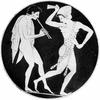- aulos
-
/aw"los/, n., pl. auloi /-loy/.an ancient Greek wind instrument, a double pipe played with a double reed.[ < Gk aulós tube, pipe, flute]
* * *
Single-or double-reed pipe usually played in pairs, particularly in ancient Greece.During the Classical period the pipes were of equal length, each with three or four finger holes. The principal wind instrument of most ancient Middle Eastern peoples, it existed in Europe up to the early Middle Ages, often as a single pipe with more finger holes. Its quavering sound, described by Plato, was classically associated with the rites of Dionysus. Auloi player with ...Courtesy of the trustees of the British Museum, London
Auloi player with ...Courtesy of the trustees of the British Museum, London* * *
in ancient Greek music, a single- or double-reed pipe played in pairs (auloi) during the Classical period. After the Classical period, it was played singly. Under a variety of names it was the principal wind instrument of most ancient Middle Eastern peoples and lasted in Europe up to the early Middle Ages.Each aulos was made of cane, wood, or metal and had three or four finger holes. The Greeks characteristically used double reeds made of cane that were held in the pipes by bulbous sockets. When played in pairs the pipes were held one in each hand and sounded simultaneously. Because of the powerful blowing necessary to sound the pipes, the Greeks often tied a phorbeia (Latin: capistrum), or leather strap, across the cheeks for additional support. During the Classical period auloi were equal in length, but this was not often true in later versions. Classical writers make few clear references to technical details for modern scholars to determine further how the instrument was played or the purpose for which it was designed.Similar modern instruments include the Sardinian launeddas, a triple pipe sounded by single reeds, as well as hosts of double clarinets—such as the arghūl, mizmār, and zamr—that are played in the Mediterranean littoral and the Middle East. The performer's cheeks often look bulged because the two single reeds vibrate continuously inside the mouth as the player uses nasal (or circular) breathing.* * *
Universalium. 2010.
